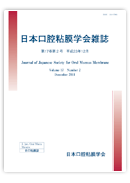In
Candida associated denture stomatitis, dentures may serve as reservoirs of
Candida species and relapses may occur when adequate management of dentures is not achieved. The purpose of this study is to examine oral
Candida species colonization on denture surface in denture wearers and to elucidate the anti-fungal effect of ozonated water.
Fungal cultures from denture surfaces were performed from 248 dentures of 149 patients with suspected
Candida stomatitis, and 168 dentures (68%) were positive for
Candida culture.
Candida albicans was the most prevalent species; it was isolated from 55% of positive dentures.
Candida glabrata was the next most prevalent (37%). Many
C.glabrata were found in combination with
C.albicans. One hundred twenty dentures were treated with ozonated water at 4 ppm in combination with ultrasonication for 10 minutes. This treatment resulted in significant reduction in the number of
Candida species. Mixed
C.albicans +
C.glabrata responded significantly poorer to ozonated water than did single species
C.albicans.
In conclusion,
C.glabrata is frequently isolated from acrylic denture surfaces of denture wearers. Ozonated water is effective in reducing the number of
Candida species on dentures. Mixed
C.albicans +
C.glabrata demonstrated more resistance to ozonated water than single
C.albicans.
View full abstract
